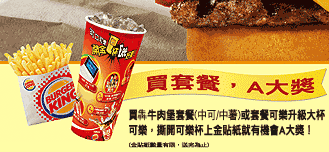Last week I was at my neighborhood shopping mall and saw an interesting ad in the Burger King there. Toward the bottom we find the following:

買套餐, A大獎
(Mǎi tàocān, A dà jiǎng)
(Buy a set meal, score a big prize.)
Here, the Roman letter “A” is used to represent a Taiwanese verb that means something like “get in an easy manner” or “make off with” — though the fine print says that customers just have a chance to get a prize, not that they necessarily will win one.
A is often used in A-qián (”A錢”: to A money), a mixed Taiwanese and Mandarin term that means embezzle/embezzlement.
Perhaps the Ministry of Education has issued an official Chinese character for this morpheme. But even if they had most people would have no idea how to read it, and it probably would be of spurious origin to boot — just like most of the other characters the ministry has issued. Where a Taiwanese morpheme sounds like the English name of a Roman letter, the romanized form is likely to prevail over the Chinese character.
There are other interesting things about this ad. But I’ll get to those in another post.

Aaah, so that’s what “A” means! I’ve seen it around increasingly in the past six to 12 months and wondered about it, but just never got around to asking about it. The one that stuck in my mind was “A??”, which I presume would mean something about getting healthy/fit the easy way then.
is this “A” pronounced as in Hanyu Pinyin “a” or Hanyu Pinyin “ei?”
is this “A” pronounced as in Hanyu Pinyin “a” or Hanyu Pinyin “ei?”
Like Pinyin’s ei or the English pronunciation of “A” (as in ABC).
In Taiwan, “A” is also commonly used in A-cài (usually written “A?”).
One of the many things I keep meaning to do is come up with a list of uses of letters of the Roman alphabet to stand in for Sinitic morphemes (e.g., “A is for A-cài, … G is for G–ròu (??)…).
Chinese (and Taiwanese) lends itself to all kinds of made-up word equivalents using numbers and letters, like “O83” for ohbasan and “OG3” for ohjisan. I’m surprised you don’t see more of them given the popularity of text messaging etc.
My favorite roman-character word is G?.
Hey, I was wondering, is the “K??” in http://img.photobucket.com/albums/v44/windelkron/IMG_1223.jpg the same sort of thing?
I do believe to “K” someone is to knock him upside the head – or less specifically, just to beat him up. I’m not sure if the etymology is Taiwanese or English (via KO – knock-out).
Unless you’re looking for books on Muhammad Ali, I don’t know how “K” has anything to do with books.
B.BarNavi: Thanks for bringing that up. I thought I’d answered N long ago but see now that I didn’t.
The usual explanation for the K in K-shu is via KO, as you note. But whether that’s real or not is unclear. Perhaps it comes from a translation from the English “hit the books,” as a K-shu is a place to study.
???B. To say nothing of G8 (the Group of Eight) vs. ??.
“[M]ost of the other characters the ministry has issued” are not spurious, though some are. Trying to use the historically accurate character was the top priority during character standardization, as I understand it.